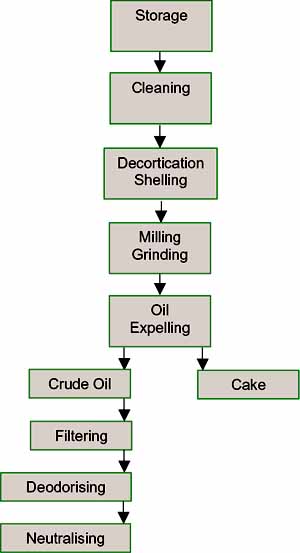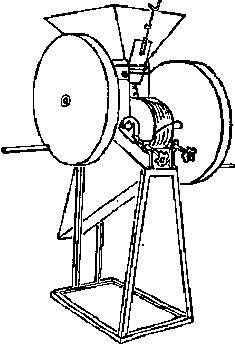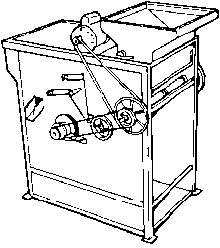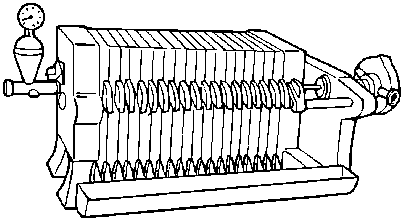Difference between revisions of "How to Process Oilseed on a Small Scale"
| Line 1: | Line 1: | ||
=Small Scale Oilseed Processing - Technical Brief= | =Small Scale Oilseed Processing - Technical Brief= | ||
| + | |||
| + | ==Short Description== | ||
| + | *'''Problem:''' | ||
| + | *'''Idea:''' | ||
| + | *'''Difficulty:''' | ||
| + | *'''Price Range:''' | ||
| + | *'''Material Needeed:''' | ||
| + | *'''Geographic Area:''' | ||
| + | *'''Competencies:''' | ||
| + | *'''How Many people?''' | ||
| + | *'''How Long does it take?''' | ||
<div class="booktext"> | <div class="booktext"> | ||
| Line 390: | Line 401: | ||
</div> | </div> | ||
| − | |||
| − | |||
| − | |||
| − | |||
| − | |||
| − | |||
| − | |||
| − | |||
| − | |||
| − | |||
| − | |||
| − | |||
| − | |||
| − | |||
| − | |||
| − | |||
| − | |||
| − | |||
| − | |||
| − | |||
| − | |||
| − | |||
| − | |||
| − | |||
| − | |||
Revision as of 13:22, 27 August 2006
Contents
- 1 Small Scale Oilseed Processing - Technical Brief
- 1.1 Short Description
- 1.2 The policy environment
- 1.3 Raw material supply
- 1.4 Marketing
- 1.5 Health and safety
- 1.6 Methods of extraction
- 1.7 Equipment required
- 1.8 Shelling or dehulling
- 1.9 Heating or conditioning
- 1.10 Expelling
- 1.11 Filtration
- 1.12 Production capacity
- 1.13 Equipment suppliers
- 1.14 References and further reading
Small Scale Oilseed Processing - Technical Brief
Short Description
- Problem:
- Idea:
- Difficulty:
- Price Range:
- Material Needeed:
- Geographic Area:
- Competencies:
- How Many people?
- How Long does it take?
Technology challenging poverty
Most countries in the world have large refineries producing cooking oil from a variety of raw materials including maize, sunflower, soya, coconut, mustard seed and groundnuts. These large centralised plants have the advantage of high efficiency and reduced costs due to the economy of scale. Despite this, in many situations smaller scale decentralised oil extraction can prove to be economic and provide opportunities for income generation. Most commonly, opportunities exist where:
• oil produced in the large refineries does not find its way out to more remote and distant rural areas.
• high transport costs are involved in wide distribution of cooking oil so increasing the price of oil.
• small farmers produce oilseeds such as groundnuts for sale to the large refineries which they then buy back, at high cost, in the form of cooking oil but without the valuable high protein oil cake.
• the crude oil is used to produce added value products, most commonly soap.
• more unusual, high value oilseeds are available; examples include Brazil Nuts, Macadamia Nuts.

Figure 1: Sunflowers grown in Kenya ©Practical Action/Morris Keyonzo
The main risks that need to be considered are:
The policy environment
In many countries the oil processing sector is highly politicised and regulations exist which make entering the market difficult and tend to support the monopoly of the large processors. Large refineries may, for example, insist that farmers sell all their seed under a contract. In other cases seed has to be sold to a central Government marketing board, the board also supplying seed for planting. To determine whether small scale processing is likely to be economic it is most important to first investigate the local situation and regulations.
Raw material supply
Clearly there must be sufficient raw material available locally. One factor that will greatly influence the viability of the enterprise will be the amount of credit needed to purchase a stock of seed. The enterprise should aim to keep the minimum stock of seed but always have enough to continue operating throughout the year. This requires considerable working capital.
Marketing
In general more profit will be made if the cooking oil is packed into retail size bottles. In many countries glass or plastic bottles are difficult to obtain and need to be purchased in large quantities so tying up capital. The possibility of using second-hand bottles should be examined as well as selling in drums to local stores. A survey need to be carried out to make sure that the packaging used meets the demands of customers. (eg size of pack, type of container)
The viability of any oil extraction enterprise depends to a considerable extent on the sale of the oil cake for use in animal feeds and other sub-products. Markets for oil cake must be investigated and demand established before processing starts.
Health and safety
As oil processing is classified as a food processing enterprise it will be subject to local legislation. Care should be taken that standards are understood and met. The particular problem of aflatoxins will require attention. Aflatoxins are natural poisons produced by certain moulds that grow on seeds and nuts. They are of considerable concern to oil seed processors and groundnuts are particularly susceptible to contamination. The growth of aflatoxin producing moulds can be prevented by correct drying and by preventing moisture pickup by raw materials in store. It is most important that those considering establishing an edible oil enterprise should be able to recognise aflatoxin producing moulds and understand how to correctly select and store raw materials. If aflatoxin is present very little passes to the extracted oil, the majority will be found in the cake remaining after extraction. Aflatoxin contaminated cake presents a real danger if incorporated in livestock feeds. As aflatoxin is difficult to remove good practice is essential to prevent any mould growth and so prevent problems.
Not all oilseed crops are suitable for processing at small scale, the most common types that are suitable include groundnut, sunflower, coconut, sesame, mustard seed, oil palm and shea nuts. Typical oil contents of common raw materials are shown in Table 1.
Table 1 Common oils and their uses
|
| ||
|
Castor |
35-55 |
Paints, lubricants |
|
Cotton |
15-25 |
Cooking oil, soaps |
|
Linseed |
35-44 |
Paints |
|
Rape/mustard |
40-45 |
Cooking oil |
|
Sesame |
35-50 |
Cooking oil |
|
Sunflower |
25-40 |
Cooking oil |
|
Nuts | ||
|
Coconut |
35 (Fresh) |
Cooking oil, soaps |
|
Groundnuts |
38-50 |
Cooking oil, soaps |
|
Palm Kernel |
46-57 |
Cooking oil, cosmetics |
|
Shea nuts |
34-44 |
Cooking oil, soaps |
|
Mesocarp Palm fruit |
av. 56 |
Cooking oil, soap |
In many cases the crude extracted oil is not suitable for human consumption until it has been refined to remove undesirable free fatty acids that taste rancid, dark colours and waxes. Refining involves considerable extra equipment costs. The most suitable oils for small and medium scale extraction are those that need little or no refining eg. mustard, sesame, groundnut, sunflower, palm and palm kernel .
Methods of extraction
Five common methods are used to extract oil:
a) Water assisted. Here the finely ground oilseed is either boiled in water and the oil that floats to the surface is skimmed off or ground kernels are mixed with water and squeezed and mixed by hand to release the oil.
b) Manual pressing. Here oilseeds, usually pre-ground, are pressed in manual screw presses. A typical press is shown in diagram 1.
c) Expelling. An expeller consists of a motor driven screw turning in a perforated cage. The screw pushes the material against a small outlet, the "choke". Great pressure is exerted on the oilseed fed through the machine to extract the oil. Expelling is a continuous method unlike the previous two batch systems.
d) Ghanis. A ghani consists of a large pestle and mortar rotated either by animal power or by a motor. Seed is fed slowly into the mortar and the pressure exerted by the pestle breaks the cells and releases the oil. Ghani technology is mainly restricted to the Indian sub-continent.
e) Solvent extraction. Oils from seeds or the cake remaining from expelling is extracted with solvents and the oil is recovered after distilling off the solvent under vacuum.
Most small enterprises will find that small expellers are the best technology choice. Methods such as water extraction and manual pressing only produce small amounts of oil per day, the extraction efficiencies are low and labour requirements high. Solvent extraction while highly efficient involves very substantial capital cost and is only economic at large scale. There are also health and safety risk from using inflammable solvents.
The basic steps involved in processing oilseeds by expeller are shown in the flow diagram below.
Equipment required
The equipment needed to set up a small or medium scale oil extraction enterprise falls into three main categories:
• pre-extraction equipment; eg dehullers, seed/kernel crackers, roasters, mills.
• extraction equipment; manual presses, ghanis, expellers
• equipment for basic refining of the oil; filters, settling tanks.
The specific equipment required will depend on the particular crop being processed, the final oil quality required and the scale of operation. In a small guide it is impossible to cover both the whole range of technical options and possible crops the following section concentrates on one example; the extraction of sunflower and groundnut oil by expeller.
Shelling or dehulling
Most oil bearing seed need to be separated from outer husk or shell. This is referred to as shelling, hulling or decortication. Shelling increases the oil extraction efficiency and reduces wear in the expeller as the husks are abrasive. In general some 10% of husk is added back prior to expelling as the fibre allows the machine to grip or bite on the material.
A wide range of manual and mechanical decorticators are available and typical examples are shown in Figure 2.
After decortication the shell may have to be separated from the kernels by winnowing. At small scale this can be done by throwing the material into the air and allowing the air to blow away the husk. At larger scale mechanical winnowers and seed cleaners are available
Heating or conditioning
Pre-heating the seeds prior to expelling speeds up the release of the oil. Pre-heating is generally carried out in a steam heated kettle mounted above the expeller.
Expelling
A wide range of makes and sizes of expellers are available. In India in particular a number of efficient small or "baby" expellers are available. A typical example with a capacity of up to 100 kg/hr is shown in figure.3. This machine has a central cylinder or cage fitted with eight separate sections or "worms". This flexible system allows single or double-reverse use and spreads wear more evenly along the screw. When the screw becomes worn only individual sections require repair thus reducing maintenance costs. As the material passes through the expeller the oil is squeezed out, exits through the perforated cage and is collected in a trough under the machine. The solid residue, oil cake, exits from the end of the expeller shaft where it is bagged.
File:SmallScale Oil Processing 5.jpeg
Figure 4: Tinytech oil expeller in operation in Zimbabwe ©Practical Action/Keith Machell
Filtration
The crude expelled oil contains solid particles. These can be removed by allowing the oil to stand and then filtering the clear oil by gravity through fine cloth. A better but more expensive method is pumping the crude oil through a filter press.
The typical system described above can be obtained for about $US 4500 (1992 price) and consists of:
Decorticator with blower to remove shell, 150 kg/hr
Boiler, 50 kg steam/hr at 30 psi
Cooker
Expeller 75 -100 kg/hr
Filter pump and press.
If filling into retail packs is planned a simple manual piston filler would be required.
Production capacity
A small mill as described above has the following capacity (based on single shift, 8 hrs/day, 24 days/month)
|
|
| |
|
Groundnut Seed |
864 |
248,832 |
|
oil litres |
260 |
74,976 |
|
oilcake |
566 |
163,164 |
|
Sunflower Seed |
720 |
207,360 |
|
oil litres |
159 |
45,888 |
|
oilcake |
522 |
150,444 |
Economic viability will be greatly increased if the mill works double shift.
In terms of employment a small oil mill would provide work for the owner/manager and four workers.
Equipment suppliers
Note: This is a selective list of suppliers and does not imply endorsement by Practical Action.
Agro Industrial Agency
Near Malaviya Vadi
Gondal Road
Rajkot - 360 002
India
Tel: +91 281 461134/462079/451214
Fax: +91 281 461770
Email: jagdishindia@hotmail.com
• "Jagdish" Tiny Oil Press
Used for the extraction of vegetable oil from oilseeds. The reverse worm system in the pressing chamber results in the highest recovery of oil.
Food Groups: Oilseeds. Capacity: 50 kg/hour
Power: Diesel/Electric
TinyTech Plants Tagore Road
Rajkot - 360 002
India
Tel: +91 281 2480166, 2468485, 2431086
Fax: +91 281 2467552
Email: tinytech@tinytechindia.com
Website: http://www.tinytechindia.com/
• Oil expellers
Capacity: 125 kg/hour. Power: Electric
• Filter Press
This is suitable for the filtration of oil. It gives transparent, very clean oil without any solid particles. Food Groups: Oilseeds
Capacity: 100-200 litres/hour
Alvan Blanch Chelworth
Malmesbury
Wiltshire
SN16 9SG
UK
Tel: +44 (0) 666 577333
Fax: +44 (0) 666 577339
• Expellers / Oil Screw Press - model mini 50
Barrel constructed from separate cast rings spaced apart by shims. The barrels are 60mm diameter by 155mm drainage length with a single piece worm shaft driven from the discharge end through a totally enclosed intermediate chain. The unit is complete with feed hopper, manual feed chute, oil discharge spout and base plate. A versatile, low cost machine, designed to suit village communities or small industries. Suitable for oil and cattle cake. Food Groups: Oilseeds
Capacity: 50 kg/hour input.
Power: Diesel/Electric
C S Bell Co
170 West Davis Street
PO Box 291
Tiffin
Ohio
USA
Tel: +1 419 448 0791
Fax: +1 419 448 1203
• No.60 Power Grist Mill
This mill is suitable for use on large and small farms. Adjustable for grinding texture. Includes hopper, feed regulator slide, coarse and fine grinding burrs and 12 inch diameter pulley. Food Groups: Cereals/Oilseeds/Herbs/spices
Capacity: 150 kg/hour
Power: Electric/Manual
Forsberg Agritech India PVT Ltd
123, GIDC Estate
Makarpura
Baroda - 390 010
India
Tel: +91 (0) 265 645752
Fax: +91 (0) 265 641683
Email: Forsagri@ad1.vsnl.net.in
• Pneumatic Aspirator / Winnower
This machine is used for "air washing" of the material to remove all dust, lights and impurities which are lighter than the seed. Winnowing of harvested and threshed seeds.
Food Groups: Cereals/Herbs/spices/Oilseeds
Ashoka Industries Kirama
Walgammulla
Sri Lanka
Tel: +94 71 764725
• Oil Expeller
Food Groups: Oilseeds
Capacity: 5 litres/hour. Power: Electric
Goldin India Equipment PVT Limited
F-29, B.I.D.C. Industrial
Estate
Gorwa
Vadodara - 390 016
Gujarat
India
Tel: +91 (0) 265 3801 168/380 461
Fax: +91 (0) 265 3801 168/380 461
Email: goldin@EQUIP.XEEBDQ.xeemail.com
• Screen Air Separator / Grain Cleaners
Most suited as precleaner before storage of seeds. Variable speed drive ensures accurate quality separations at high capacity. Totally enclosed aspiration system with cyclone provides dust free working in the plant.
Food Groups: Cereals/Herbs/spices/Oilseeds/Vegetables Capacity: 100 - 2000 kg/hour. Power: Battery/Electric
Flower Food Company
91/38 Ram Indra Road,
Soi 10, Km 4
Bangkok
Thailand
Tel: +66 2 5212203 / 5523420
• Seed Decorticator Machine
Food Groups: Oilseeds
Capacity: 500 kg/hour. Power: Electric
Nigerian Oil Mills Ltd
P.O.Box 264
Atta
Owerri
Imo-State
Nigeria
• Milling Machine / Mills and Grinders
This machine is used for crushing palm kernels, groundnut seeds and moringa seeds to extract oil.
Food Groups: Oilseeds/Nuts/Herbs/spices
Power: Electric/Manual
• Oil Expeller
This machine is used for crushing palm kernels, groundnut seeds and moringa seeds to extract oil. Food Groups: Oilseeds/Nuts/Herbs/spices
Power: Electric/Manual
References and further reading
• The Manual Screw Press: For small-scale oil extraction Kathryn H. Potts and Keith Machell, ITDG Publications 1995
• Small Scale Vegetable Oil Extraction S.W. Head et al, NRI, ISBN 085954 387 0



